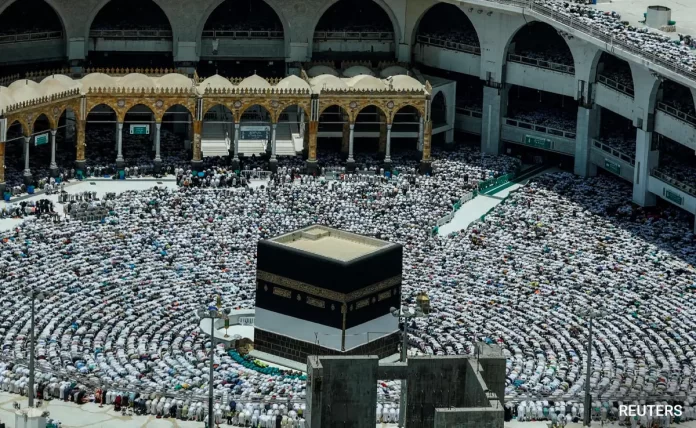– Adnan M Shaikh
Hajj and Eid al-Adha are two of the most significant observances in Islam, each imbued with profound meaning and spiritual depth. Together, they epitomize Muslim devotion, unity, and charity, serving as powerful reminders of the values that underpin the Islamic faith.
The Spiritual Journey of Hajj
Hajj, the pilgrimage to Makkah, is one of the Five Pillars of Islam and a pivotal spiritual journey for Muslims worldwide. Each year, millions of Muslims converge on Makkah to fulfill a divine commandment and attain spiritual rejuvenation. Preparing for Hajj involves not only logistical planning but also deep spiritual readiness. As pilgrims don the simple white garments of Ihram, they shed their worldly identities, symbolizing purity and equality before Allah.
The pilgrimage includes a series of sacred rituals, each rich in spiritual significance and historical roots. The Tawaf, the act of circling the Ka’bah seven times, represents the centrality of Allah in a Muslim’s life. This practice dates back to the time of Prophet Ibrahim (Abraham) and his son, Ismael, who constructed the Ka’bah as the first house of worship dedicated to Allah. The Sa’i, which involves walking between the hills of Safa and Marwah, commemorates Hagar’s desperate search for water for her son, Ismael, illustrating themes of perseverance and trust in divine providence.
One of the most spiritually profound moments of Hajj is the Day of Arafat. Pilgrims gather on the plain of Arafat, engaging in earnest prayer and reflection, seeking Allah’s mercy and forgiveness. This communal act of devotion powerfully reminds believers of the Day of Judgment, symbolizing a spiritual rebirth and renewal of faith. The significance of Arafat is deeply rooted in Islamic history, marking the place where Prophet Muhammad ﷺ delivered his Farewell Sermon, encapsulating the core principles of Islam. Key points from the sermon include:
“O People! Listen to me in earnest, worship Allah, say your five daily prayers, fast during the month of Ramadan, and give your wealth in Zakat. Perform Hajj if you can afford it.”
“O People, it is true that you have certain rights with regard to your women, but they also have rights over you. Treat your women well and be kind to them, for they are your partners and committed helpers.”
“All mankind is from Adam and Eve. An Arab has no superiority over a non-Arab, nor a non-Arab over an Arab; a white has no superiority over a black, nor a black over a white, except by piety and good action.”
“I leave behind me two things, the Quran and the Sunnah (prophetic teachings), and if you follow these, you will never go astray.”
Hajj concludes with the symbolic ritual of stoning the Jamarat, where pilgrims throw pebbles at three pillars, representing the rejection of evil and reaffirming their commitment to Allah. This ritual traces back to Prophet Ibrahim’s defiance of Satan’s temptations, reinforcing the themes of faith and resistance against sin.
Eid al-Adha: The Festival of Sacrifice
Coinciding with the completion of Hajj is Eid al-Adha, the Festival of Sacrifice, which commemorates Prophet Ibrahim’s (Abraham’s) unwavering faith and willingness to sacrifice his son in obedience to Allah. This festival underscores themes of sacrifice, devotion, and charity.
Central to Eid al-Adha is the ritual of Qurbani, the sacrifice of an animal. The meat from this sacrifice is divided into three parts: one-third for the family, one-third for friends and relatives, and one-third for those in need. This act of sharing ensures that all community members, especially the less fortunate, can partake in the festive meals, reinforcing the values of generosity and social responsibility.
Eid al-Adha is marked by communal prayers, festive gatherings, and the sharing of meals. Muslims come together in mosques and open spaces for the special Eid prayer, followed by the exchange of greetings and the sharing of traditional foods and sweets. This celebration fosters a sense of community and solidarity, strengthening the bonds of love and friendship among family and friends.
The Interconnected Significance
The intertwining of Hajj and Eid al-Adha highlights the core values of Islam: faith, sacrifice, and charity. Hajj, as a physical and spiritual journey, brings Muslims together from around the world, emphasizing the unity and equality of all believers. It is a time of intense spiritual reflection, repentance, and renewal.
Eid al-Adha complements this by translating the spiritual lessons of Hajj into acts of charity and community service. The ritual of Qurbani and the widespread acts of giving during Eid al-Adha reflect the importance of supporting those in need and fostering a compassionate and just society.
In recent years, advancements in technology and infrastructure have made Hajj more accessible and safer for millions of pilgrims. Initiatives such as the expansion of the Grand Mosque in Makkah, improved health services, and enhanced crowd management systems have significantly reduced the risks associated with large gatherings. These improvements have not only ensured the safety and well-being of pilgrims but have also facilitated a more profound and uninterrupted spiritual experience.




